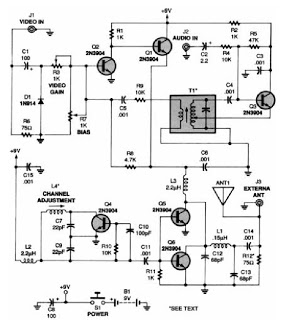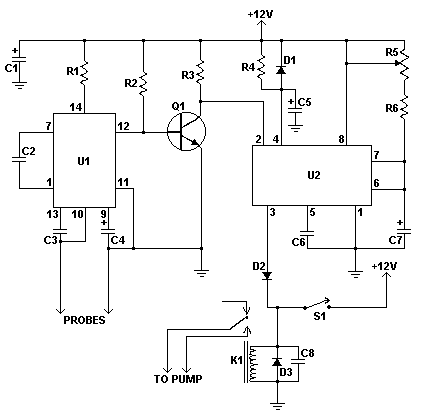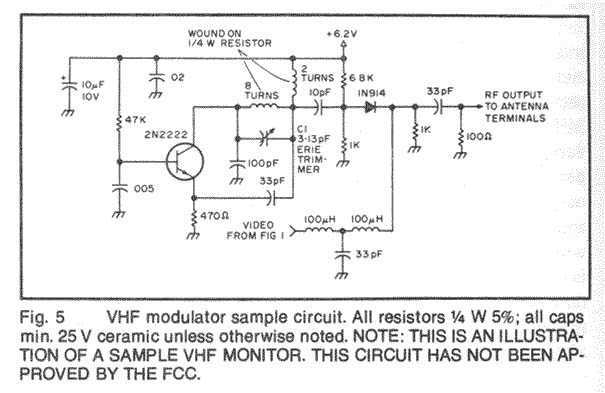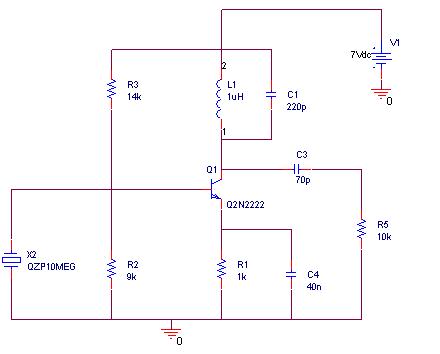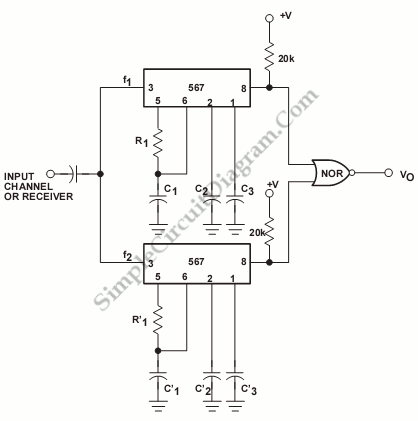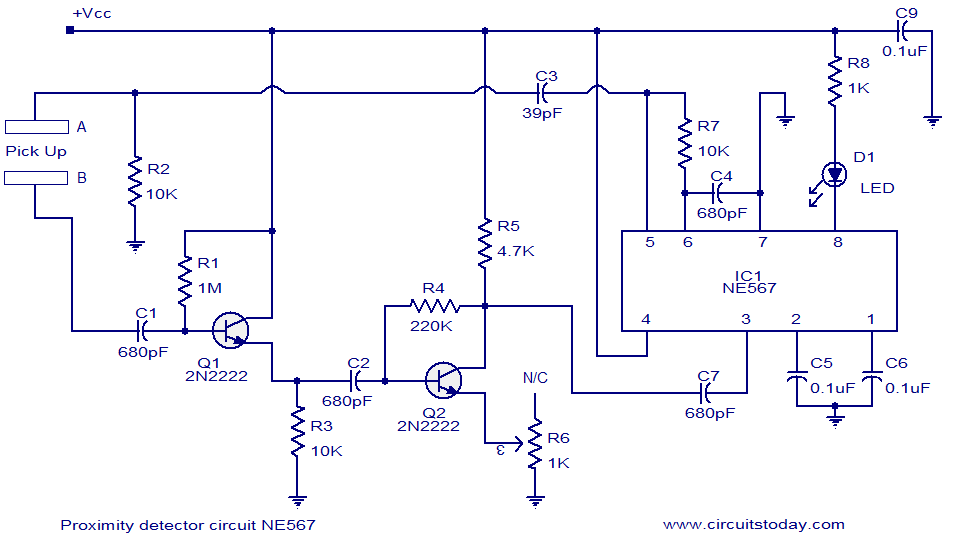
Surveillance Transmitter Detector
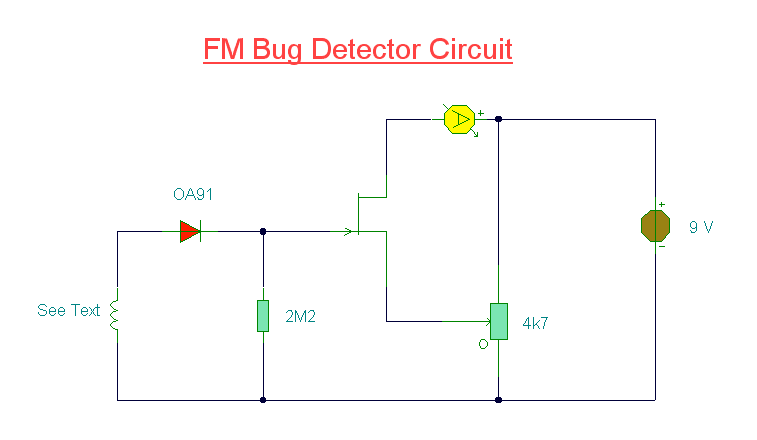
The site features several low-power transmitters, but until now, there has been no receiver. This circuit can be utilized to scan an area or room, indicating whether a surveillance device is active. The challenge in creating an effective detector lies in achieving the appropriate sensitivity; excessive sensitivity may cause it to respond to radio broadcasts, while insufficient sensitivity will result in no detection. The project requires only a few components, can be constructed on veroboard, and is powered by a 9-volt battery for ease of portability. The prototype, demonstrated below, functioned adequately on a Eurobreadboard. The circuit operates simply, utilizing a molded RF coil with a value of 0.389 µH, available from Maplin Electronics under order code UF68Y. This coil possesses a high Q factor of approximately 170 and is untuned or broadband. When tested with an oscillator, the circuit responded to frequencies ranging from 70 MHz to 150 MHz, which encompasses the majority of FM bugs designed to operate within the commercial receiver range of 87 - 108 MHz. The RF signal captured by the coil, which also responds to AM or FM modulation or a plain carrier wave, is rectified by the OA91 diode. This small DC voltage is sufficient to alter the bias of the FET, providing an indication on the meter. The FET can be either an MPF102 or a 2N3819, while the meter depicted in the image is sourced from Maplin Electronics, order code LB80B, featuring a full-scale deflection of 250 µA. Meters with a full-scale deflection of 50 or 100 µA may be employed for enhanced sensitivity. During operation, the preset is adjusted to achieve a zero reading on the meter. The detector is then moved around the room, where a small battery transmitter will cause the meter to deflect from a distance of a few feet.
This circuit design offers a straightforward approach to detecting the presence of surveillance devices within a given area. The use of a molded RF coil with a specific inductance value ensures that the circuit is sensitive to the desired frequency range, facilitating the detection of common surveillance signals. The high Q factor of the coil enhances the circuit's selectivity, allowing it to discriminate between the target signals and unwanted radio frequency interference.
The rectification process performed by the OA91 diode converts the alternating current (AC) signals received from the RF coil into a direct current (DC) voltage. This DC voltage is pivotal for biasing the Field Effect Transistor (FET), which acts as a signal amplifier. The choice of FET, whether MPF102 or 2N3819, provides flexibility in component selection based on availability and performance characteristics. The output from the FET is then measured by the analog meter, which visually indicates the presence of RF signals.
The adjustable preset resistor plays a crucial role in calibrating the circuit, allowing the user to set a baseline reading on the meter before scanning the environment. This feature enhances usability, ensuring that the circuit can be fine-tuned for optimal performance based on the specific conditions of the area being surveyed.
Overall, this circuit is a practical and efficient solution for individuals seeking to detect unauthorized surveillance devices, combining portability, simplicity, and effectiveness in its design.My site contains a few low power transmitters of one type or another, but until now no receiver. This circuit can be used to "sweep" an area or room and will indicate if a surveillance device is operative. The problem in making a suitable detector is to get its sensitivity just right; too much and it will respond to radio broadcasts, too little se
nsitivity and nothing will be heard. This project has few components, can be made on veroboard and powered from a 9 volt battery for portability. My prototype shown below, worked OK on a Eurobreadboard. Circuit operation is simple. The inductor is a moulded RF coil, value of 0. 389uH and is available from Maplin Electronics, order code UF68Y. (See my links page for component suppliers. ) The coil has a very high Q factor of about 170 and is untuned or broadband. With a test oscillator this circuit responded to frequencies from 70 MHz to 150 MHz, most of the FM bugs are designed to work in the commercial receiver range of 87 - 108 MHz.
The RF signal picked up the coil, and incidentally this unit will respond to AM or FM modulation or just a plain carrier wave, is rectified by the OA91 diode. This small DC voltage is enough to upset the bias of the FET, and give an indication on the meter. The FET may by MPF102 or 2N3819, the meter shown in the picture is again from Maplin Electronics, order code LB80B and has a 250 uA full scale deflection.
Meters with an FSD of 50 or 100 uA may be used for higher sensitivity. In use the preset is adjusted for a zero reading on the meter. The detector is then carried around a room, a small battery transmitter will deflect the meter from a few feet away. 🔗 External reference
This circuit design offers a straightforward approach to detecting the presence of surveillance devices within a given area. The use of a molded RF coil with a specific inductance value ensures that the circuit is sensitive to the desired frequency range, facilitating the detection of common surveillance signals. The high Q factor of the coil enhances the circuit's selectivity, allowing it to discriminate between the target signals and unwanted radio frequency interference.
The rectification process performed by the OA91 diode converts the alternating current (AC) signals received from the RF coil into a direct current (DC) voltage. This DC voltage is pivotal for biasing the Field Effect Transistor (FET), which acts as a signal amplifier. The choice of FET, whether MPF102 or 2N3819, provides flexibility in component selection based on availability and performance characteristics. The output from the FET is then measured by the analog meter, which visually indicates the presence of RF signals.
The adjustable preset resistor plays a crucial role in calibrating the circuit, allowing the user to set a baseline reading on the meter before scanning the environment. This feature enhances usability, ensuring that the circuit can be fine-tuned for optimal performance based on the specific conditions of the area being surveyed.
Overall, this circuit is a practical and efficient solution for individuals seeking to detect unauthorized surveillance devices, combining portability, simplicity, and effectiveness in its design.My site contains a few low power transmitters of one type or another, but until now no receiver. This circuit can be used to "sweep" an area or room and will indicate if a surveillance device is operative. The problem in making a suitable detector is to get its sensitivity just right; too much and it will respond to radio broadcasts, too little se
nsitivity and nothing will be heard. This project has few components, can be made on veroboard and powered from a 9 volt battery for portability. My prototype shown below, worked OK on a Eurobreadboard. Circuit operation is simple. The inductor is a moulded RF coil, value of 0. 389uH and is available from Maplin Electronics, order code UF68Y. (See my links page for component suppliers. ) The coil has a very high Q factor of about 170 and is untuned or broadband. With a test oscillator this circuit responded to frequencies from 70 MHz to 150 MHz, most of the FM bugs are designed to work in the commercial receiver range of 87 - 108 MHz.
The RF signal picked up the coil, and incidentally this unit will respond to AM or FM modulation or just a plain carrier wave, is rectified by the OA91 diode. This small DC voltage is enough to upset the bias of the FET, and give an indication on the meter. The FET may by MPF102 or 2N3819, the meter shown in the picture is again from Maplin Electronics, order code LB80B and has a 250 uA full scale deflection.
Meters with an FSD of 50 or 100 uA may be used for higher sensitivity. In use the preset is adjusted for a zero reading on the meter. The detector is then carried around a room, a small battery transmitter will deflect the meter from a few feet away. 🔗 External reference
